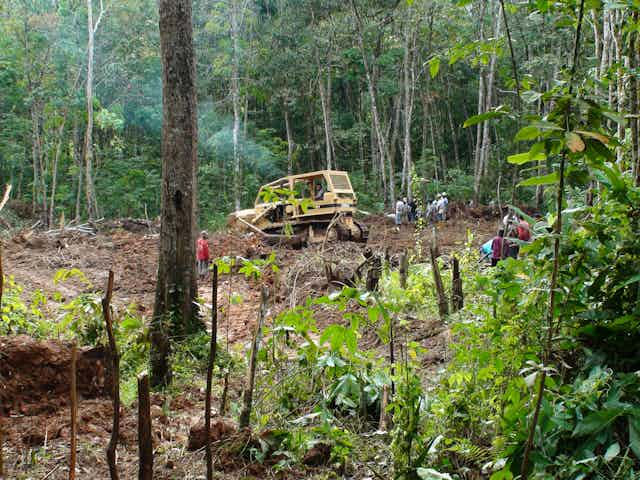Conserving tropical rainforests is the single greatest thing we can do to reduce carbon emissions, according to shadow environment minister Greg Hunt. Hunt will use Australia’s leadership of the 2014 G20 meeting in Brisbane to broker a deal on rainforests and carbon reductions.
But we already have a global deal on tropical rainforests, known as Reducing Emissions from Deforestation and Degradation, or REDD (with added economic benefits it is termed REDD+).
The framework rewards conservation of forests and reduction of carbon emissions from clearing and burning. These reductions can then offset emissions elsewhere, for example, in Australia once the ETS kicks in.
But REDD has suffered from the lack of a regulated market for carbon credits, and an overburden of aspirations. Can the initiative be saved, or is it doomed for extinction?
Deforestation is a tropical disease. In the decade to 2010, 83 million hectares of tropical forests were lost globally, around 12 times the size of Tasmania. Half of this deforestation is attributed to subsistence farmers seeking land for their families to survive.
Intact tropical forests store huge amounts of carbon, and support much of the world’s biodiversity. They have a vital role to play in conservation of biodiversity and climate change mitigation.
REDD was conceived in 1992 at Rio and formalised in 2007 at the Bali conference of the United Nations Framework Convention on Climate Change (UNFCCC).
Conserving forests through REDD promised wealth enough to be shared with forest-dependent communities, forest managers and the state. Believers in both private and government sectors kept REDD alive through sequential UNFCCC meetings.
Few private corporations still believe in REDD because regulated markets for the carbon credits generated from REDD have not emerged since the Bali conference. Without such a market, REDD could be heading for extinction.
So, how does REDD actually work?
The first step is to figure out the historical rates for deforestation and losses of forest carbon. Once deforestation is stopped, the emissions reductions are measured, reported and verified. Finally the resulting carbon credits can be traded.
Proponents receive payment for reducing emissions. But to stop deforestation and reward subsistence farmers for doing so, proponents must be confident they can sell carbon emissions, preferably in a regulated market.
Without a regulated market, the voluntary market is the only market for REDD carbon credits, sold mostly in large bilateral deals rather than multiple trades. This market is self-accredited through agencies like the Climate, Community and Biodiversity Alliance and its Standard, and the Verified Carbon Standard. By designing a project around these standards, the project can be accredited and provide a level of confidence for buyers of carbon offsets.
But if this is the only market for REDD credits, then regulation of REDD carbon units is not important. In a voluntary market, buyers may value forest project qualities other than carbon reductions, including biodiversity, landscapes, and livelihoods. Without international regulation of carbon units, REDD just becomes a component of certification in a green economy.
If REDD has lost its power in the private sector, it continues to enchant governments. For governments, REDD has magical properties – able to finance change in governance of forest resources and include rural communities in coordinated management of landscapes – the money flowing from governments in the global “north” to those in the “south”.
For example, in 2010 Norway offered US$1 billion to help Indonesia stop deforestation. To receive this money the Indonesian government has to improve forest governance. In response Indonesia placed moratoria on granting new forest concession licences. This helps constrain corporations from clearing forests, but does little to protect forests from desperate subsistence farmers.
But government interest in REDD too is under threat. It has become so burdened with aspirational criteria that it is unable to work effectively. These aspirations, each of them worthy in their own right, include gender, equity, indigenous knowledge and rights, capacity building, governance, transparency, stakeholder participation. This is on top of the fundamentals of conservation, biodiversity, carbon measurement, reporting and verification.
Australia’s own investment in REDD has suffered this fate. Having fed A$100 million into its Kalimantan Forest Carbon Partnership, the Australian government quietly euthanized the program.
As REDD guardians increase the environmental, social, economic, cultural and governmental expectations of tropical forests, the forest themselves are disappearing.
We need to go back to REDD roots - it’s about forests and people – and use investment in forest protection to improve livelihoods at the local level. Learning by doing. It wont be perfect, but if we wait for perfection we will only be certifying tropical grasslands.
Intergovernmental agreement on a regulated market seems a pipe dream – there are too many aspirations and agendas. Instead, we need brave investors in the voluntary market place who recognise the upside of saving forests and improving the livelihoods of some of the poorest people on the planet. And for the next government of Australia to keep REDD credits, voluntary or otherwise, in an ETS.

